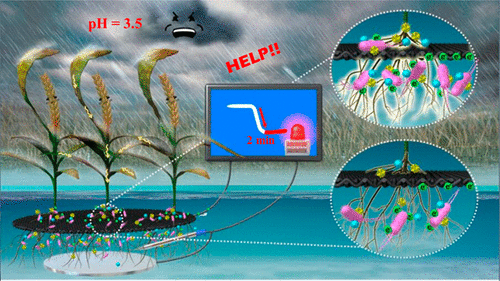Our official English website, www.x-mol.net, welcomes your
feedback! (Note: you will need to create a separate account there.)
Swift Acid Rain Sensing by Synergistic Rhizospheric Bioelectrochemical Responses
ACS Sensors ( IF 8.2 ) Pub Date : 2018-07-03 00:00:00 , DOI: 10.1021/acssensors.8b00401 Tian Li 1 , Xin Wang 1 , Qixing Zhou 1 , Chengmei Liao 1 , Lean Zhou 1 , Lili Wan 1 , Jingkun An 2 , Qing Du 1 , Nan Li 2 , Zhiyong Jason Ren 3
ACS Sensors ( IF 8.2 ) Pub Date : 2018-07-03 00:00:00 , DOI: 10.1021/acssensors.8b00401 Tian Li 1 , Xin Wang 1 , Qixing Zhou 1 , Chengmei Liao 1 , Lean Zhou 1 , Lili Wan 1 , Jingkun An 2 , Qing Du 1 , Nan Li 2 , Zhiyong Jason Ren 3
Affiliation

|
Acid rain poses significant threats to crops and causes a decline in food production, but current monitoring and response to acid rain damage is either slow or expensive. The direct damage observation on plants can take several hours to days when the damage is irreversible. This study presents a real time bioelectrochemical monitoring approach that can detect acid rain damage within minutes. The rhizospheric bioelectrochemical sensor (RBS) takes advantage of the fast chain responses from leaves to roots, and then to the microbial electrochemical reactions in the rhizosphere. Immediate and repeatable current fluctuations were observed within 2 min after acid rain, and such changes were found to correspond well to the changes in rhizospheric organic concentration and electrochemical responses. Such correlation not only can be observed during acid rain events that can be remedied via rinsing, but it was also validated when such damage is irreversible, resulted in zero current, photosynthetic efficiency, and electrochemical signals. The alanine, aspartate, and glutamate metabolism and galactose metabolism in leaves and roots were inhibited by the acid rain, which resulted in the decrease of rhizodeposits such as fumaric acid, d-galactose, and d-glucose. These changes resulted in reduced electroactivity of anodic microorganisms, which was confirmed by a reduced redox current, a narrower spectrum in differential pulse voltammetry, and the loss of peak in the Bode plot. These findings indicate that the RBS process can be a simple, swift, and low-cost monitoring tool for acid rain that allows swift remediation measures, and its potential may be broadened to other environmental monitoring applications.
中文翻译:

协同的根际生物电化学反应快速监测酸雨
酸雨对农作物构成重大威胁,并导致粮食减产,但目前对酸雨损害的监测和应对要么缓慢要么昂贵。当损害不可逆转时,对植物的直接损害观察可能需要数小时至数天。这项研究提出了一种实时生物电化学监测方法,可以在数分钟内检测到酸雨损害。根际生物电化学传感器(RBS)利用了从叶到根,然后到根际微生物电化学反应的快速链反应。在酸雨后的2分钟内观察到立即且可重复的电流波动,发现这种变化与根际有机物浓度和电化学响应的变化非常吻合。这种相关性不仅可以在酸雨事件中观察到,可以通过冲洗进行纠正,而且还可以在这种破坏不可逆转,导致零电流,光合作用效率和电化学信号时得到验证。酸雨抑制了叶和根中丙氨酸,天冬氨酸和谷氨酸的代谢以及半乳糖的代谢,从而导致了富马酸等根茎沉积的减少,d-半乳糖和d-葡萄糖。这些变化导致阳极微生物的电活性降低,这可以通过氧化还原电流降低,差分脉冲伏安法中的光谱更窄以及波德图中的峰损失来确认。这些发现表明,RBS过程可以是一种简单,快速且低成本的酸雨监测工具,可以采取迅速的补救措施,并且其潜力可能会扩展到其他环境监测应用程序中。
更新日期:2018-07-03
中文翻译:

协同的根际生物电化学反应快速监测酸雨
酸雨对农作物构成重大威胁,并导致粮食减产,但目前对酸雨损害的监测和应对要么缓慢要么昂贵。当损害不可逆转时,对植物的直接损害观察可能需要数小时至数天。这项研究提出了一种实时生物电化学监测方法,可以在数分钟内检测到酸雨损害。根际生物电化学传感器(RBS)利用了从叶到根,然后到根际微生物电化学反应的快速链反应。在酸雨后的2分钟内观察到立即且可重复的电流波动,发现这种变化与根际有机物浓度和电化学响应的变化非常吻合。这种相关性不仅可以在酸雨事件中观察到,可以通过冲洗进行纠正,而且还可以在这种破坏不可逆转,导致零电流,光合作用效率和电化学信号时得到验证。酸雨抑制了叶和根中丙氨酸,天冬氨酸和谷氨酸的代谢以及半乳糖的代谢,从而导致了富马酸等根茎沉积的减少,d-半乳糖和d-葡萄糖。这些变化导致阳极微生物的电活性降低,这可以通过氧化还原电流降低,差分脉冲伏安法中的光谱更窄以及波德图中的峰损失来确认。这些发现表明,RBS过程可以是一种简单,快速且低成本的酸雨监测工具,可以采取迅速的补救措施,并且其潜力可能会扩展到其他环境监测应用程序中。











































 京公网安备 11010802027423号
京公网安备 11010802027423号